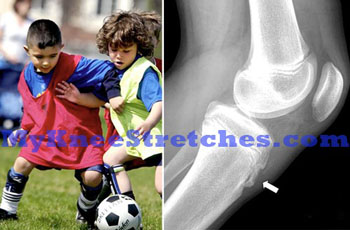Children in growing age are prone to knee pain syndromes. Generally, knee pain comes out as a traumatic reaction between bone growth and ligaments. In some cases, physical injuries during sports and other activities lead to it. In rare cases, congenital factor plays the major role. However, children nowadays are often pushed to do lots of activities to stimulate their growth. Unbalanced growth between bone and muscle, on the other hand, can lead to knee pain. Knee pain is identified by almost similar symptoms for different diseases. However, there is no reason to generalize all of them since the treatment can be different for each type. Let’s see these various knee pain syndromes.
Common Causes of Knee Pain in Children
Normally, active kids with rapid growth, one day would find out that they feel an unusual pain on and under knee caps. Light injury would be gone in one or two days. Specific injuries can stay for few weeks to months, or even till they become adult. The symptoms typically start from swelling knee, bruises and redness. Upon x-ray examination, in some cases you would see effusion, dislocation, separated fragments and even fractured bones. To some extent, kids would suffer from fever as the reaction to deal with the pain and changes. Physically, kids tend to get limp.
The most usual one is Osgood-Schlatter Disease (OSD) or overuse injury in short. Though the name comes out really serious, this knee pain is what kids often suffer from. As the name tells, OSD is the result of overworking muscles and bones. It doesn’t have to be because your kids exercise too much, It is most likely caused by the unbalanced speed of growing bone and muscle. During rapid growth period, even simple exercise like jumping and running can cause OSD with girls.They are the major sufferers, since they tend to bend their muscle inward. OSD would resolve by itself after 12 or even 24 months. However, in acute OSD case, it’s recommended to let doctor examine it as mistreatment can lead to long-term OSD.

Knee Pain in Children
Another case upon traumatic damage is Juvenile Rheumatoid Arthritis (Juvenile R.A.) – See Details. Arthritis indicates the inflammation of the knuckles. In Juvenile R.A. case, our antibody cells (white blood cells) can’t differentiate between supportive body cells and bacteria. Consequently, white blood cells would fight against the useful cell tissues and lead to inflammation. The pain would stay for weeks and months and it cannot resolve by itself.
Some knee pain syndromes tend to be gender-wise, as girls and boys can have different pattern of joint-involved actions. Parapatellar Syndrome and Patellofemoral Dislocations are tend to be suffered by girls due to their unusual joint reaction while doing sports. These syndromes are basically identified by separated fragment or joint dislocation. In rare Habitual Patellofemoral Dislocation cases, the syndrome is caused congenitally, which the sufferer has inherited a shortened extensor mechanism to their joint from their parents. The most usual case (not habitual) is caused by twisting falls and false stretching. On the other hand, boys tend to suffer from Osteochondritis dissecans (OCD).Boys tend to do group exercises which involves the knee, like soccer or basketball. In soccer, tackling action, sliding and falling often lead to OCD. This syndrome occurs on lateral aspect of medial collateral ligament (MCL) and lateral collateral ligament (LCL),which are caused by trauma and failed ossification.This is often found out by swelling, extreme pain and separated fragment.
Some rare knee pain cases like meniscal tears and ACL injuries can happen as well. Both cases are caused by joint disruption. In meniscal tears case, sufferers are indicated by lateral joint pain and often locking. In examination, it would be seen that meniscus forms into a shape of letter ‘D’. ACL injuries are caused by degenerative joint.
Knee Pain in Children: Treatment and Care
There are a lot of treatment options to heal knee pain syndromes. For usual case like OSD, time would also heal, but to deal with the pain, heating pads and muscle-pain killer, like ibuprofen and NSAIDs would help. Dislocation would be best treated by surgery. ACL injuries, meniscal tears, OCD, Parapatellar syndrome and Patellofemoral dislocations are related to separate fragments and joint dislocations, so surgery would be the answer. In some cases of Juvenile R.A., sufferers can be treated periodically by physical therapy.
However, we have many options to avoid such knee pain syndromes. Before doing exercise for knee, ask the children to do stretching. After exercising, you can put ice on the knee or heating pads if they start getting pain. In some cases when sufferers have wrong habitual joint actions, they can be treated with physical therapy. Attaching knee pads to protect their knee from getting damaged is also highly recommended. Even though we have NSAIDs and ibuprofen to relieve the pain, do not ever underestimate any knee pain syndromes. Tell the difference by how long they suffer from pain. If it’s going for months and even years, there must be something wrong with the joint and visit the doctor as fast as possible.

